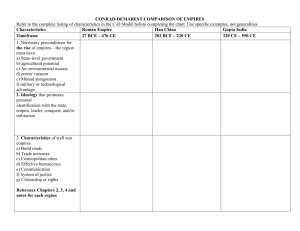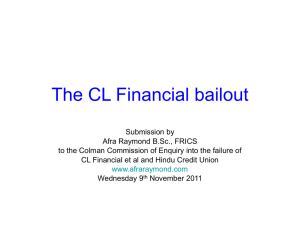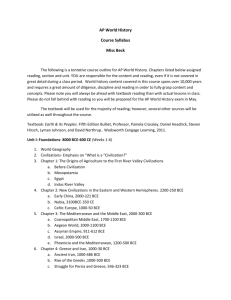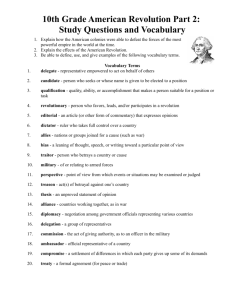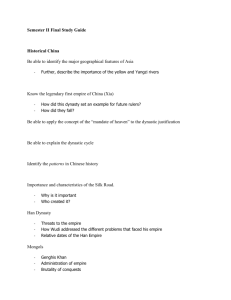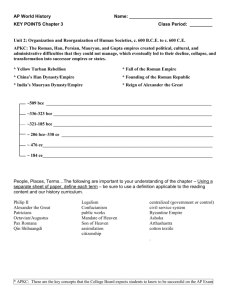Patterns of Interaction
advertisement
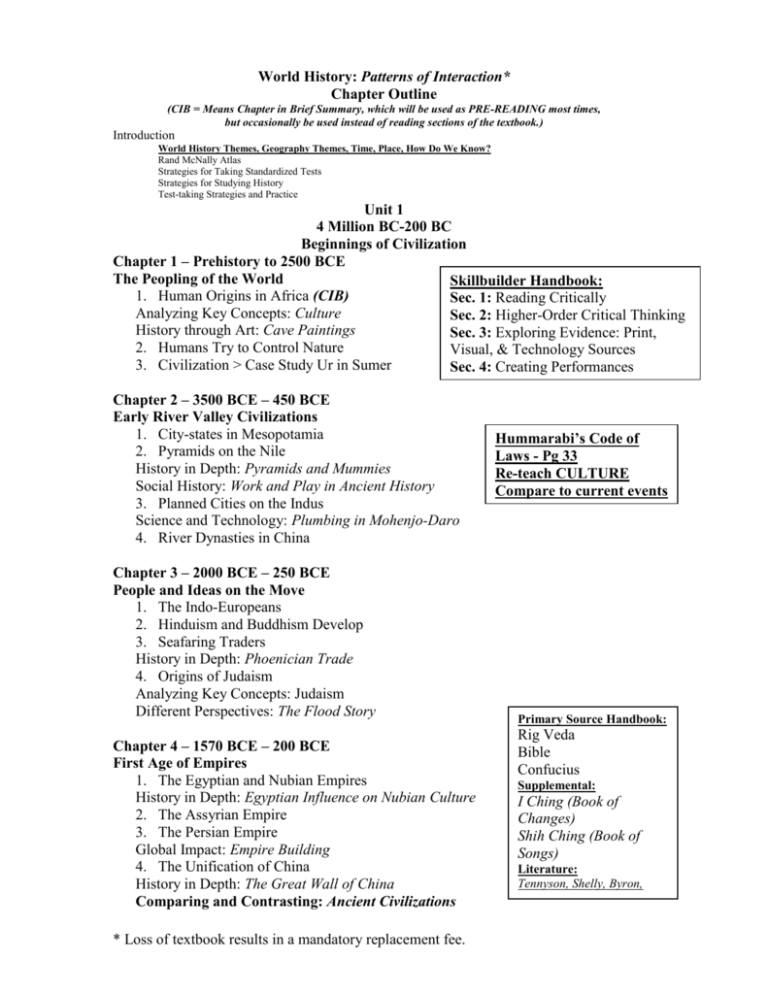
World History: Patterns of Interaction* Chapter Outline (CIB = Means Chapter in Brief Summary, which will be used as PRE-READING most times, but occasionally be used instead of reading sections of the textbook.) Introduction World History Themes, Geography Themes, Time, Place, How Do We Know? Rand McNally Atlas Strategies for Taking Standardized Tests Strategies for Studying History Test-taking Strategies and Practice Unit 1 4 Million BC-200 BC Beginnings of Civilization Chapter 1 – Prehistory to 2500 BCE The Peopling of the World Skillbuilder Handbook: 1. Human Origins in Africa (CIB) Sec. 1: Reading Critically Analyzing Key Concepts: Culture Sec. 2: Higher-Order Critical Thinking History through Art: Cave Paintings Sec. 3: Exploring Evidence: Print, 2. Humans Try to Control Nature Visual, & Technology Sources 3. Civilization > Case Study Ur in Sumer Sec. 4: Creating Performances Chapter 2 – 3500 BCE – 450 BCE Early River Valley Civilizations 1. City-states in Mesopotamia 2. Pyramids on the Nile History in Depth: Pyramids and Mummies Social History: Work and Play in Ancient History 3. Planned Cities on the Indus Science and Technology: Plumbing in Mohenjo-Daro 4. River Dynasties in China Chapter 3 – 2000 BCE – 250 BCE People and Ideas on the Move 1. The Indo-Europeans 2. Hinduism and Buddhism Develop 3. Seafaring Traders History in Depth: Phoenician Trade 4. Origins of Judaism Analyzing Key Concepts: Judaism Different Perspectives: The Flood Story Chapter 4 – 1570 BCE – 200 BCE First Age of Empires 1. The Egyptian and Nubian Empires History in Depth: Egyptian Influence on Nubian Culture 2. The Assyrian Empire 3. The Persian Empire Global Impact: Empire Building 4. The Unification of China History in Depth: The Great Wall of China Comparing and Contrasting: Ancient Civilizations * Loss of textbook results in a mandatory replacement fee. Hummarabi’s Code of Laws - Pg 33 Re-teach CULTURE Compare to current events Primary Source Handbook: Rig Veda Bible Confucius Supplemental: I Ching (Book of Changes) Shih Ching (Book of Songs) Literature: Tennyson, Shelly, Byron, Unit 2 2000 BCE – 800 CE New Directions in Government and Society Chapter 5 – 2000 BCE – 300 CE Classical Greece Primary Source Handbook: 1. Cultures of Mountains and Sea Thucydides 2. Warring City-States Plato History in Depth: Festivals and Sports 3. Democracy and Greece’s Golden Age History through Art: Greek Art and Architecture 4. Alexander’s Empire 5. The Spread of Hellenistic Culture Chapter 6 – 500 BCE – 500 CE Ancient Rome and Early Christianity Primary Source Handbook: 1. The Roman Republic Tacitus 2. The Roman Empire Social History: Life in a Roman Villa 3. The Rise of Christianity 4. The Fall of the Roman Empire Chicago History Fair: Different Perspectives: The Fall of the Roman Empire Planning Begins! 5. Rome and the Roots of Western Civilization TOPIC / THESIS DUE Analyzing Key Concepts: Western Civilization Science and Technology: The Coliseum Chapter 7 – 400 BCE – 550 CE India and China Establish Empires 1. India’s First Empires 2. Trade Spreads Indian Religion and Culture History through Art: Hindu and Buddhist Art 3. Han Emperors in China Global Impact: Trade Networks Chapter 8 – 1500 BCE – 700 CE African Civilization 1. Diverse Societies in Africa Science and Technology: African Ironworking 2. Migration Case Study: Bantu-Speaking People 3. The Kingdom of Aksum Chapter 9 – 40,000 BCE – 700 CE The Americas: A Separate World (CIB) 1. The Earliest American 2. Early Meso-American Civilizations History through Art: Olmec Sculpture 3. Early Civilizations of the Andes History in Depth: Narzca Lines Comparing and Contrasting: Classical Ages * Loss of textbook results in a mandatory replacement fee. Chicago History Fair: RESEARCH PLAN DUE Chicago History Fair: RESEARCH DATA & WORKING BIBLIOGRAPHY DUE Chicago History Fair: OUTLINE LINKED TO RESEARCH DATA DUE Unit 3 500 – 1500 An Age of Exchange and Encounter Chapter 10 – 600-1200 The Muslim World 1. The Rise of Islam Analyzing Architecture: The Dome of the Rock 2. Islam Expands 3. Muslim Culture Science and Technology: Astronomy Primary Source Handbook: Qu’ran WORLD RELIGIONS AND ETHICAL SYSTEMS Buddhism Christianity Hinduism Islam Judaism Confucianism Chapter 11 – 500 – 1500 Byzantines, Russians, and Turks Interact 1. The Byzantine Empire Analyzing Key Concepts: Roman Catholicism and Easter Orthodoxy 2. The Russian Empire History through Art: Religious Art and Architecture 3. Turkish Empires Rise in Anatolia Chapter 12 – 600 – 1350 Primary Source Handbook: Empires and East Asia Sei Shōnagon 1. Tang and Song China Supplemental: Social History: Tang and Song Dynasty: People and Technology Journey to the West 2. The Mongol Conquests History in Depth: A Mighty Fighting Force 3. The Mongol Empire Chicago History Fair: 4. Feudal Empires in Japan ROUGH DRAFT DUE History in Depth: Japanese Samurai 5. Kingdoms of Southeast Asia and Korea Chapter 13 – 500 – 1200 European Middle Ages 1. Charlemagne Unites Germanic Kingdoms 2. Feudalism in Europe Analyzing Key Concepts: Feudalism 3. The Age of Chivalry (CIB) Science and Technology: Castles and Siege Weapons 4. The Power of the Church (CIB) * Loss of textbook results in a mandatory replacement fee. Chicago History Fair: PROJECT DUE: FEB. 2 LAST DAY TO TURN IN UNDER ANY CIRCUMSTANCES! SCHOOL FAIR: FEB 16. REGIONAL FAIR: SATURDAY, MARCH 24. Chapter 14 – 800-1500 Formation of Western Europe 1. Church Reform and the Crusades (CIB) History in Depth: Gothic Architecture Different Perspectives: The Crusades 2. Changes in Medieval Society 3. England and France Develop 4. The Hundred Years’ War and the Plague (CIB) Global Impact: The Spread of Epidemic Disease Primary Sources: Magna Carta Chapter 15 – 800 – 1500 Societies and Empires in Africa 1. North and Central African Societies 2. Western African Civilizations History through Art: Benin Bronzes 3. Eastern City States and Southern Empires Analyzing Architecture: Great Zimbabwe Comparing and Contrasting: Trade Networks Unit 4 500 – 800 Connecting Hemispheres Chapter 16 – 500 – 1500 People and Empires in America 1. North American Series 2. Maya Kings and Cities History through Art: Maya Architecture 3. The Aztecs Control Central Mexico History in Depth: Aztec Calendar 4. The Inca Create a Mountain Empire Social History: Incan Mummies Primary Source Handbook: Popul Vuh Chapter 17 – 1300 – 1600 European Renaissance and Reformation 1. Italy: Birthplace of the Renaissance History through Art: Renaissance Ideas influence Renaissance Art 2. The Northern Renaissance Primary Source Handbook: Social History: City Life in Renaissance Europe Nicholas Machiavelli 3. Luther Leads the Reformation The Prince Analyzing Key Concepts: Protestantism Sir Thomas More 4. The Reformation Continues Utopia Different Perspectives: The Reformation Chapter 18 – 1300 – 1700 The Muslim World Expands 1. The Ottomans Build a Vast Empire 2. Cultural Blending Case Study: The Safavid Empire 3. The Mughal Empire in India * Loss of textbook results in a mandatory replacement fee. History through Art: Cultural Blending in Mughal India Chapter 19 – 1400 – 1800 An Age of Explorations and Isolation (CIB) 1. Europeans Explore the East 2. Science and Technology: The Tools of Exploration 3. China Limits European Contacts History in Depth: The Forbidden City 4. Japan Returns to Isolation Primary Source: Ship Comparison DBQ Chapter 20 – 1492 – 1800 The Atlantic World (CIB) 1. Spain Builds an American Empire (CIB) Different Perspectives: The Legacy of Columbus 2. Europeans Nations Settle North America 3. The Atlantic Slave Trade (CIB) 4. The Columbian Exchange and Global Trade (CIB) Global Impact: Food Exchange Analyzing Key Concepts: Mercantilism Comparing and Contrasting: Methods of Government Unit 5 1500 – 1900 Absolutism to Revolution Chapter 21 – 1500 – 1800 Absolute Monarchs in Europe 1. Spain’s Empire and European Absolutism Analyzing Key Concepts: Absolutism 2. The Reign of Louis XIV History in Depth: The Palace at Versailles 3. Central European Monarchs Clash 4. Absolute Rulers of Russia Social History: Surviving the Russian Winter 5. Parliament Limits the English Monarchy Primary Source Handbook: Chapter 22 – 1550 – 1789 Spring Break Enlightenment and Revolution 1. The Scientific Revolution 2. The Enlightenment of Europe Different Perspectives: European Values during the Enlightenment 3. The Enlightenment Spreads 4. The American Revolution Analyzing Key Concepts: Democracy Chapter 23 – 1789 – 1815 The French Revolution and Napoleon 1. The French Revolution Begins 2. Revolution Brings Reform and Terror Science and Technology: Guillotine * Loss of textbook results in a mandatory replacement fee. James Madison Federalist Papers Mary Wollstonecraft Rights of Women Primary Source Handbook: Elizabeth Vigée-Lebrun Memoirs Different Perspectives: The French Revolution 3. Napoleon Forges an Empire (CIB) 4. Napoleon’s Empire Collapses (CIB) 5. The Congress Vienna (CIB) Chapter 24 – 1789 – 1900 Nationalist Revolutions Sweep the West 1. Latin American Peoples Win Independence (CIB) Global Impact: Struggling Towards Democracy 2. Europe Faces Revolution (CIB) Analyzing Key Systems: Nationalism 3. Nationalism (CIB) Case Study: Italy and Germany 4. Revolutions in the Arts History through Art: Revolutions in Painting Comparing and Contrasting: Political Revolutions Primary Source Handbook: Sadler Committee Report on Child Labor Unit 6 1700 – 1914 Industrialism and the Race for Empire Chapter 25 – 1700 – 1900 The Industrial Revolution 1. The Beginnings of Revolution Global Impact: Revolutions in Technology 2. Industrialization Case Study: Manchester 3. Industrialization Spreads 4. Reforming the Industrial World Analyzing Key Concepts: Capitalism vs. Socialism Different Perspectives: Industrialization Chapter 26 – 1815 – 1914 An Age of Democracy and Progress 1. Democratic Reform and Activism (CIB) 2. Self-Rule for British Colonies Social History: Life in Early Australia 3. War and Expansion in the United States (CIB) 4. Nineteenth-Century Progress (CIB) Science and Technology: Edison’s Inventions Chapter 27 – 1850 – 1914 The Age of Imperialism 1. The Scramble for Africa 2. Imperialism Case Study: Nigeria Analyzing Key Concepts: Imperialism Different Perspectives: Views of Imperialism 3. Europeans Claim Muslim Lands 4. British Imperialism in India 5. Imperialism in Southeast Asia * Loss of textbook results in a mandatory replacement fee. Primary Source Handbook: Abraham Lincoln Second Inaugural Elizabeth Cady Stanton Rights of Women Chapter 28 – 1800 – 1914 Transformations around the Globe 1. China Resists Outside Influence (CIB) 2. Modernization in Japan (CIB) History through Art: Japanese Woodblock Printing 3. U.S. Economic Imperialism Science and Technology: Panama Canal 4. Turmoil and Change in Mexico Comparing and Contrasting: Scientific and Technological Changes Primary Source Handbook: Woodrow Wilson The Fourteen Points Unit 7 1900 – 1945 The World at War Chapter 29 – 1914 – 1918 The Great War 1. Marching Toward War 2. Europe Plunges into War History in Depth: The New Weapons of War Science and Technology: Military Aviation 3. A Global Conflict Different Perspectives: Views of War 4. A Flawed Peace Chapter 30 – 1900 – 1939 Revolution and Nationalism 1. Revolutions in Russia Analyzing Key Concepts: Communism 2. Totalitarianism Case Study: Stalinist Russia Analyzing Key Concepts: Totalitarianism History through Art: Propaganda 3. Imperial China Collapses History in Depth: The Long March 4. Nationalism in India and Southwest Asia Chapter 31 – 1819 – 1939 Years of Crisis 1. Postwar Uncertainty Social History: Labor-saving Devices in the United States 2. A Worldwide Depression 3. Fascism Rises in Europe Analyzing Key Concepts: Fascism 4. Aggressors Invade Nations Chapter 32 – 1939 – 1845 World War II 1. Hitler’s Lightening War 2. Japan’s Pacific Campaign 3. The Holocaust * Loss of textbook results in a mandatory replacement fee. Supplementary Sources: Stars: Stories of Holocausts PBS: Sugihara Primary Source Handbook: Elie Wiesel Night Jeanne Wakatsuki Houston Farewell to Manzanar 4. The Allied Victory Global Impact: Arming for War 5. Europe and Japan in Ruins Comparing and Contrasting: The Changing Nature of Warfare Unit 8 1945 – Present Perspectives on the Present Chapter 33 – 1945 – Present Restructuring the Post-War World 1. Cold War – Super Powers Face Off (CIB) Science and Technology: The Space Race 2. Communists Take Power in China (CIB) 3. Wars in Korea and Vietnam 4. The Cold War Divides the World (CIB) History in Depth: How the Cold War was Fought 5. The Cold War Thaws (CIB) Chapter 34 – 1945 – Present The Colonies Become New Nations 1. The Indian Subcontinent Achieves Freedom 2. Southeast Asian Nations Gain Independence Social History: Changing Times in Southeast Asia 3. New Nations in Africa 4. Conflicts in the Middle East History in Depth: Signs of Hope 5. Central Asia Struggles Supplementary Sources: Gandhi Chapter 35 – 1945 – Present Primary Source Handbook: Struggles fir Democracy Nelson Mandela 1. Democracy Inaugural Address Case Study: Latin America Democracies Supplementary Sources: 2. The Challenge of Democracy in Africa Mandela and DeKlerk 3. The Collapse of the Soviet Union 4. Change in Central and Eastern Europe History in Depth: Ethnic Groups in the Former Yugoslavia 5. China: Reform and Reaction History through Art: Photojournalism Chapter 36 – 1945 – Present Global Interdependence Primary Source Handbook: 1. The Impact of Science and Technology Martin Luther King 2. Global Economic Development I Have a Dream Analyzing Key Concepts: Globalization Cesar Chavez Different Perspective: Economics and the Environment An Open Letter 3. Global Security Issues 4. Terrorism > Case Study: September 11, 2001 5. Cultures Blend in a Global Age > Global Impact: Rock ‘n Roll Comparing and Contrasting: Nation Building * Loss of textbook results in a mandatory replacement fee.
